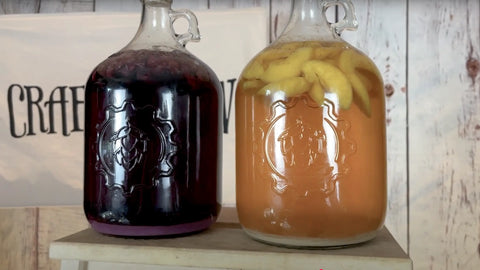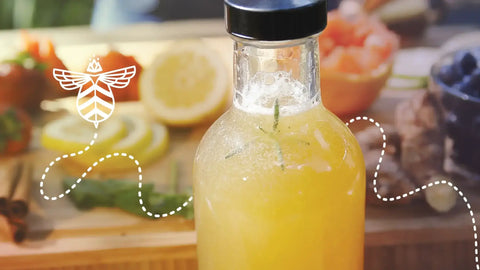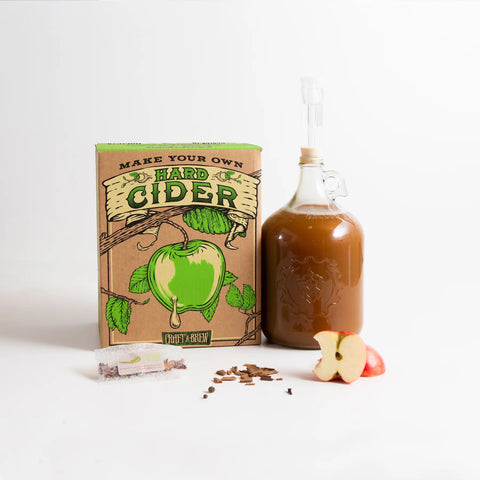TL;DR: Mead with Fruit (Melomel)
Melomel is a type of mead with fruit, combining honey, water, and yeast with the addition of berries, stone fruits, or tropical fruit. Adding fruit to mead can happen in primary fermentation for subtle flavors, or in secondary fermentation for bold, fresh character. Sanitizing fruit, balancing sweetness and acidity, and aging properly are key to a successful homemade fruit mead.
What is a Melomel?
Mead is often called “honey wine,” since it’s made by fermenting honey with water and yeast. But when you add fruit to mead, it becomes a melomel — one of the most popular mead variations.
Fruit doesn’t just add flavor and aroma; it also contributes natural sugars that can boost alcohol content and complexity. Learning how to make melomel opens up endless possibilities for unique combinations, from tart berry melomels to tropical or spiced creations.
Best Fruits to Use in Mead
Choosing the right fruit makes all the difference in a melomel recipe. Here are some great options for mead brewing with fruit:
-
Berries (blueberry, raspberry, blackberry, cranberry): Bring tartness, vibrant color, and rich aroma.
-
Stone fruits (cherry, peach, plum, apricot): Add juicy sweetness and wine-like depth.
-
Tropical fruits (pineapple, mango, passionfruit): Deliver exotic, aromatic flavors.
-
Apples & pears: Create a hybrid style called a cyser, somewhere between mead and cider.
👉 Pro Tip: Frozen fruit is an excellent choice for your melomel recipe.
-
Freezing breaks down cell walls, helping extract more flavor and sugars during fermentation.
-
Frozen fruit is flash frozen at the peak of freshness for optimal flavor.
-
It also has lower risk of microbial contaminants than fresh fruit.
When to Add Fruit
Adding fruit to mead can happen at different stages, each creating different results:
-
Primary fermentation:
-
Fruit is added to the must (unfermented mead) on Day 1 and ferments alongside honey.
-
While it produces well-integrated fruit flavor, fruit flavor and aroma are often more subtle.
-
When fruit is present in primary fermentation, delicate fruit aromas and flavors can be pushed out through the airlock.
-
Secondary fermentation: (our preferred method)
-
Fruit is added after aggressive fermentation activity subsides (around 2 weeks).
-
Adding fruit once fermentation calms helps preserve fuller, fresher fruit aroma and flavor for bolder fruit character in your glass.
-
This method is preferred if your melomel recipe features mellow, delicate fruit like peaches or blueberries. Also ideal for expensive or exotic fruits.
👉 Pro Tip: Adding fruit to mead in BOTH primary and secondary can create layered fruit flavor and depth in the finished product!
How Much Fruit to Use in a Melomel Recipe
For balanced flavor in a homemade fruit mead, use about 1-4 lb of fruit per gallon. Using 3lb of fruit per gallon is ideal for sufficient flavor and color contribution. Using 1-2 lb of fruit per gallon will yield milder fruit character.
You can add all of the fruit in primary or in secondary. OR you can divide your total fruit, using half in primary and half in secondary.
-
If you have a fermenter with ample headspace (a 2 gallon bucket for a 1 gallon batch), feel free to use 3-4 lb of fruit per gallon! Using at least 3lb of fruit ensures sufficient flavor and color contribution.
-
If your fermenter has limited headspace, like a 1 gallon carboy, use just 1-2 lb of fruit per gallon. Carboys don’t offer a lot of headspace and fruit pulp tends to clog airlocks, creating messy overflow.
Tips for Successful Melomels
To set your melomel up for success, follow these core practices:
-
Sanitize the fruit – when using fresh fruit there’s a higher risk of wild yeast or microbes on the skins. Sterilize fruit with a 5 minute stove-top simmer. OR add a crushed Campden Tablet to the must 24 hours before adding yeast to sterilize the fruit. Frozen fruit or packaged purees are considered safe to use.
-
Contain the fruit - fruit skins, pulp & seeds account for a lot of sediment. Use a nylon straining bag to minimize seeds, skins & pulp in your finished mead.
-
Use the right fermenter - when fermenting with fruit, use a vessel with ample headspace. A 2 gallon bucket is ideal for 1 gallon meads! If you only have access to a 1 gallon carboy, reduce your fruit volume to 1 lb to prevent clogging or messy blow-off.
-
Balance sweetness – yeast will ferment most fruit sugars, leaving the melomel quite dry. Consider backsweetening with honey after fermentation to adjust the balance.
-
Be patient – fruit adds fermentable sugars to your mead. Yeast require more time to ferment in high-gravity (high-sugar) environments. Fruit meads benefit from at least 3-4 weeks on the fruit and a few months of aging in bottles to mellow and round out the flavors.
Sample Melomel Recipe: Strawberry Banana Mead
This 1 gallon melomel recipe uses fruit in primary fermentation. You can adapt this recipe with other frozen fruits or blends.
Ingredients (1 gallon batch):
-
2.5 lbs raw honey
-
3 lb frozen strawberries & bananas, defrosted
-
0.5 tsp pectic enzyme
-
1 packet of K1-V1116 wine yeast
-
Yeast Nutrients (Fermaid-O, Fermaid-K, or Craft a Brew’s blend, etc.)
-
1 gallon water
-
Optional: 12 oz honey for backsweetening
-
Optional: stabilizer (Craft a Brew’s blend, or 0.5 tsp Potassium Sorbate + 1 Campden Tablet)
Process:
-
Add thawed fruit to a straining bag in a fermenter (bucket with headspace recommended). Add honey, pectic enzyme, and water.
-
Pitch yeast and first nutrient dose. Ferment 3 weeks, punching down fruit daily in week one.
-
Remove fruit bag after 2 weeks, squeeze juice back into fermenter.
-
Rack mead into a carboy to separate sediment. Age until clear.
-
Once clear, you can stabilize 24 hours before backsweetening with honey. Bottle as usual.
Sample Melomel Recipe: Peach Mead
This 1 gallon melomel recipe uses fruit in secondary fermentation. You can adapt this recipe with other frozen fruits or blends.
Ingredients (1 gallon batch):
-
2.5 lbs honey
-
1-2 lb frozen peaches (or other fruit), defrosted
-
1 packet of D47 Wine Yeast
-
Yeast Nutrients (Fermaid-O, Fermaid-K, or Craft a Brew’s blend, etc.)
-
Just under 1 gallon of water
-
Optional: 12 oz honey for backsweetening
-
Optional: stabilizer (Craft a Brew’s blend, or 0.5 tsp Potassium Sorbate + 1 Campden Tablet)
Process:
-
Dissolve honey in water, leaving headspace for fruit (mead should fall below the 1 gallon fill line). Pitch yeast and nutrients. Ferment 2 weeks.
-
Add thawed peaches directly to fermenter (or use a straining bag). Continue fermenting 3+ weeks.
-
Rack mead into a carboy to separate sediment. Age until clear.
-
Optionally stabilize, backsweeten, and bottle.
-
Once clear, you can stabilize 24 hours before backsweetening with honey. Bottle as usual.
Final Thoughts: Why Make a Melomel?
Mead brewing with fruit is one of the most rewarding ways to experiment at home. Melomels showcase vibrant colors, layered aromas, and flavor complexity that evolve beautifully with aging. Whether you prefer crisp summer berry melomels or rich, spiced holiday versions, learning how to make melomel is a fun and flavorful journey.
Ready to Make Mead with Fruit?
Explore our Mead Making Kits and Mead Recipe Refills to start crafting your own homemade fruit mead. Everything you need for your first melomel is just a click away.





